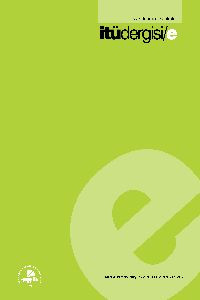Öz
Bu çalışmada evsel atıksularda yaygın olarak bulunan glikozun biyolojik fosfor giderimi üzerine etkisi incelenmiştir. Laboratuvar ortamında glikozla beslenen anaerobik-aerobik Ardışık Kesikli Reaktörler (AKR) işletilmiş; çalışma süresince proses performansında ve mikrobiyal türlerde meydana gelen değişimler izlenmiştir. AKR’nin ilk döneminde Biyolojik Aşırı Fosfor Giderimi (BAFG) aktif olarak görülmüştür. Ancak reaktörün ikinci döneminde BAFG aktivitesi bozulmaya başlamış, son döneminde ise kabarma problemi ile karşılaşılmış ve koşullar iyileştirilemediği için işletilmesine son verilmiştir. AKR’nin başlangıç döneminde laktik asit oluşması ve oluşan laktik asitin anaerobik süreçte tüketilmesi sonucu fermentasyon bakterileri ile fosfor depolayan organizmaların (PAO) biyolojik fosfor giderimini birlikte gerçekleştirdiği belirlenmiştir. Laktik asit bakterilerinin glikozu laktik asite fermente ettiği ve PAO’ların anaerobik fosfor salınımından enerji sağlayarak oluşan laktik asidi polihidroksialkonata (PHA) dönüştürdüğü düşünülmüştür. Bu dönemdeki mikroskobik gözlemlerde poli-P depolayan kokların yoğun olarak görülmesi ve filogenetik analiz sonucunda Firmicutes filumuna ait Lactococcus türlerinin mikrobiyal topluluğun önemli bir bölümü olarak tespit edilmesi bu varsayımı desteklemektedir. Ayrıca oluşan PHA’nın %77’sinin 3-hidroksivalerat (3HV) olması ve anaerobik süreçte laktik asitin tüketilmesi laktik asitin PAO’larca kullanılan esas karbon kaynağı olduğunu kanıtlamaktadır. AKR’nin 29’uncu gününde glikojen depolayan organizmalar (GAO) olarak tanımlanan Candidatus Competibacter Phosphatis türü filogenetik analizde yoğun olarak gözlemlenmiş ve BAFG aktivitesinin bozulmasının bu türün baskı hale gelmesinden kaynaklandığı belirlenmiştir. 29’uncu günle birlikte glikojen tüketiminin önemli miktarda artması, glikoz tüketimine karşı salınan fosfor değerinin (0.07 mol P/ mol C) düşmesi sistemde GAO’ların aktif olduğunu göstermektedir.
Anahtar Kelimeler
Biyolojik aşırı fosfor giderimi fosfat depolayan organizmalar glikojen depolayan organizmalar glikoz
Kaynakça
- Cech, J.S. ve Hartman, P., (1993). Competition between polyphosphate and polysaccharide accumulating bacteria in enhanced biological phosphate removal systems, Water Research, 27, 7, 1219-1225.
- Crocetti, G.R., Banfield, J.F., Keller, J., Bond, P.L. ve Blackall, L.L., (2002). Glycogen-accumulating organisms in laboratory scale and full-scale wastewater treatment processes, Microbiology, 148, 3353-3364.
- Dubois, M., Gilles, K.A., Hamilton, J.K., Rebers, P.A. ve Smith, F., (1956). Colometric method for determination of sugars and related substances, Analytical Chemistry, 28, 350-356.
- Hollender, J., van der Krol, D., Kornberger, L., Gierden, E. ve Dott, W., (2002). Effect of different carbon sources on the enhanced biological phosphorus removal in a sequencing batch reactor, World Journal of Microbiology and Technology, 18, 355-360.
- Jeon, C.J. ve Park, J.M., (2000). Enhanced biological phosphorus removal in a sequencing batch reactor supplied with glucose as a sole carbon source, Water Research, 34, 7, 2160-2170.
- Kong, Y.H., Beer, M., Seviour, R.J., Lindrea, K.C. ve Rees, G.A., (2001). Structural and functional analysis of the microbial community an an aerobic: anaerobic sequencing batch reactor (SBR) with no phosphorus removal, Systematic and Applied Micobiology, 24, 597-609.
- Liu, W.T., Mino, T., Nakamura, K. ve Matsuo, T., (1996). Glycogen accumulating population and its anaerobic substrate uptake in anaerobic-aerobic activated sludge without biological phosphorus removal, Water Research, 30, 1, 75-82.
- Liu, Y.H., (1998). Relation between sludge carbohydrate content and biological phosphate removal, Water Research, 32, 5, 1635-1641.
- Mino, T., van Loosdrecht, M.C.M. ve Heijnen, J.J., (1998). Microbiology and biochemistry of the enhanced biological phosphate removal process. Water Research, 32, 11, 3193-3207.
- Randall, A.A., Benefield, L.D. ve Hill, W.E., (1994). The effect of fermentation products on enhanced biological phosphorus removal, polyphosphate storage, and microbial population dynamics, Water Science and Technology, 30, 6, 213-219.
- Satoh, H., Mino, T. ve Matsuo, T., (1992). Uptake of organic substrates and accumulation of polyhydroxyalkanoates linked with glycolysis of intracellular carbohydrates under anaerobic conditions in the biological excess phosphate removal processes, Water Science and Technology, 26, 5-6, 933-942.
- Satoh, H., Ramey, W.D., Koch, F.A., Oldham, W.K., Mino, T. ve Matsuo, T., (1996). Anaerobic substrate uptake by the enhanced biological phosphorus removal activated sludge treating real sewage, Water Science and Technology, 34, 1-2, 9-16.
- Standard Methods for the Examination of Water and Wastewater, (1995). 19th edn. American Public Health Assocaition/American Water Works Association/Water Environment Federation, Washington DC, USA.
- Wang, N., Peng, J. ve Hill, G., (2002). Biochemical model of glucose induced enhanced biological phosphorus removal under anaerobic condition, Water Research, 36, 49-58.
Ayrıntılar
| Birincil Dil | Türkçe |
|---|---|
| Konular | Su Kaynakları ve Su Yapıları |
| Bölüm | Lisansüstü tezlerden üretilmiş makaleler |
| Yazarlar | |
| Yayımlanma Tarihi | 31 Aralık 2009 |
| Yayımlandığı Sayı | Yıl 2009 Cilt: 19 Sayı: 1-2 |


